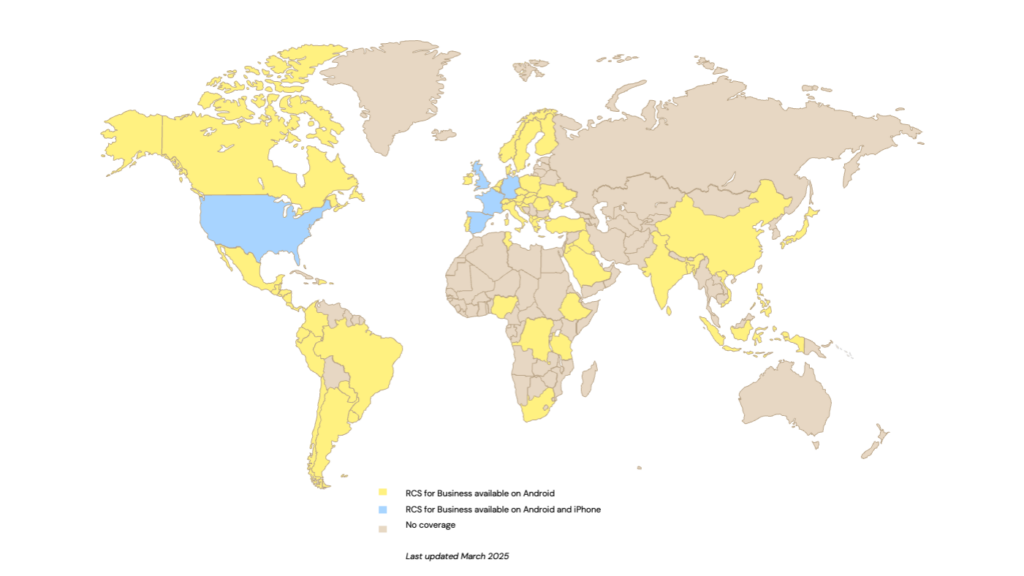Insights
10 questions to ask before you transition from SMS to RCS

Insights

Let’s be honest: Most of the messages your team sends over SMS aren’t flashy. They’re functional: One-time passwords (OTPs), alerts, and order confirmations. You probably choose SMS because it’s instant, it’s globally supported, and it works every time.
So, why consider another messaging channel?
Rich Communication Services (RCS) might sound like a more complex, “marketing-first” messaging channel. But it actually solves real problems that SMS users deal with every day, like dealing with random sender information and inability to identify brands. RCS keeps everything you already like about SMS (reliability, simplicity, growing global support) and adds branded sender identities, more insights, and an improved and polished customer experience.
We’ve pulled together 10 practical questions every product or customer experience lead should ask themselves before considering moving their messaging from SMS to RCS. Spoiler: It’s simpler than you think, and you can start small.
Let’s start with the basics. RCS is not yet supported everywhere for business messaging. RCS for Business is available on Android devices in most markets, and Apple has started rolling it out in some countries with some carriers. That means:

What you can do today: Register your brand for an RCS Agent (think: your official business profile in an RCS for Business message). Even if you’re not ready to launch, registration gets you set up and ready to submit your Agent for approval when coverage expands. More information on this process is below.
One of the best parts of sending RCS messages via a provider like Sinch is our “RCS when you can, SMS when you can’t” approach.
What we mean by that is that if you send an RCS message and a customer’s phone or carrier doesn’t support RCS yet, your message automatically gets sent as a normal SMS instead. That’s it. You don’t need to create two message versions or manage multiple delivery paths. We handle all that logic behind the scenes.
You might be thinking about all the integration work that usually goes into adding a new tool to your organization’s tech stack. And while integrating RCS may require some development work, it’s designed to be a smooth process, especially if you’re already set up for SMS. If you’re already sending SMS through platforms like Salesforce, HubSpot, or a custom CRM, Sinch works with all the tools you already use.
That means you don’t have to start from scratch, and you can keep your existing flows and triggers you use with SMS – RCS just upgrades what your customers see.
Every RCS for Business message has to come from an RCS Agent (that’s your branded business profile), and every Agent needs to be registered as having a defined purpose, called a “use case.”
There are four use case categories for RCS business messaging:
You might think that your best option would be to just use a multi-use use case – but just note that users who opt out from these messages will stop getting all messages from you, even transactional ones.
Learn more about agent use cases for RCS for Business messaging.
Specific RCS prices can vary depending on your use case and the country you’re sending messages in, but here’s a simple way to think about it:
Unless you register for session-based pricing (which is carrier-dependent), each sent message is billed separately. If you’re already used to SMS billing, this will feel familiar.
Yes. In fact, RCS is more secure than SMS in many ways because RCS messages are encrypted in transit and always come from a branded, verified sender profile. That makes phishing a whole lot harder via RCS than it currently is via SMS.
Are RCS messages secure? Sinch’s Miriam Liszewski discusses how RCS adds extra layers of security over SMS, making them great for sending sensitive messages like OTPs.
Just keep in mind that you need to register a dedicated OTP or Transactional Agent if you’re sending this type of message. This helps ensure your traffic stays compliant and doesn’t get flagged.
RCS gives you way more visibility into how your customers interact than SMS. RCS gives you detailed insights like:
That means you can A/B test content, optimize flows, and track conversion rates, just like you probably already do with email or in-app messaging.
Hopefully by now you’re thinking about all the ways you can use RCS to communicate with your customers. And while you’re right – there are a lot of possibilities – RCS has tighter content rules than SMS.
Every RCS for Business message is subject to Google’s Acceptable Use Policy and possibly additional carrier rules. Some content you can send over SMS might not be acceptable to send over RCS. For example, you can’t send political-related messages, and you can’t promote the sale of tobacco products or services.
Basically, make sure to check your use case against policies and regulations before registering your RCS Agent. Sinch can help guide you through this – the more clearly you define your use case up front, the smoother the approval process will be.
If you already send SMS, you’re probably already familiar with how stringent compliance is for messaging. When it comes to RCS, compliance works a lot like SMS.
Google requires that when someone says they want to stop getting messages, your agent needs to respect that. Be sure to check your local laws and best practices for handling opt-out requests the right way.
Before you can send RCS messages, your business needs to first register an RCS Agent. This is your official “business card” of sorts that shows your name, logo, and business information in your RCS messages.
Here’s what you’ll need to provide to get approved as an RCS Agent:
Some carriers will also require a fallback number for SMS/MMS if an RCS message can’t be delivered. Sinch can help you figure out if this is needed in your market and will handle the submission process with Google and mobile carriers. We can also support you in navigating other market-specific requirements, so you’re covered from the start.
Pro tip: Align your RCS Agent setup with your existing SMS numbers and flows. If you already have one short code for OTPs and another for promotions, keep that logic in your RCS setup too for SMS fallback.
RCS can feel like a big change, with different message types, new terminology, and different rules than what you’re used to with SMS. But we’re here to tell you that the process of switching from SMS to RCS doesn’t have to be complicated. You can start small.
That’s why we recommend businesses already sending SMS to just upgrade their existing SMS messages to RCS when the user’s device supports it. When it doesn’t, they’ll get an SMS instead. You don’t lose anything, and your customers with RCS-enabled devices get a better experience that’s branded and more secure.
And later, if you feel like moving to richer capabilities, you can. But there’s no pressure to go all-in from day one.
Curious to hear from a brand that did just this? Check out the EasyPark case study to see how they used both RCS with SMS fallback to deliver important notifications.
Wherever you are in your messaging journey, Sinch can help you transition from SMS to RCS with minimal disruption. Let us know when you’re ready to get started – our team is happy to help you create messaging experiences your customers will love!